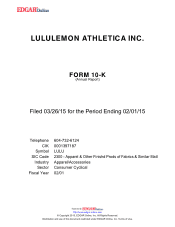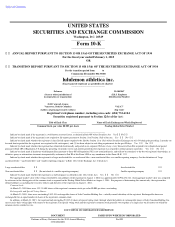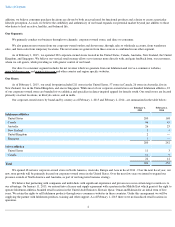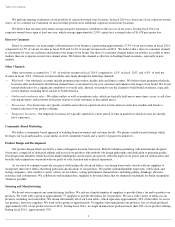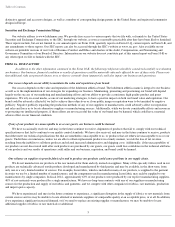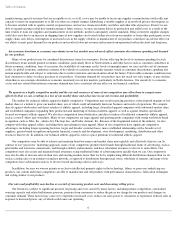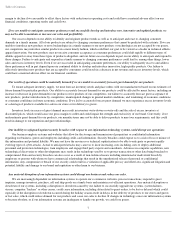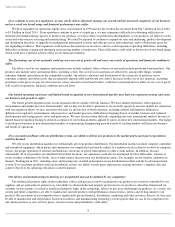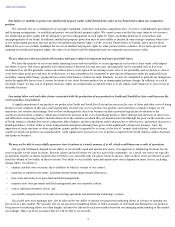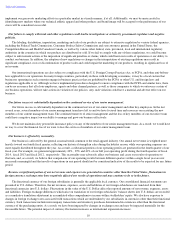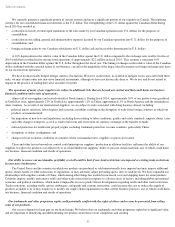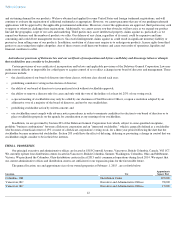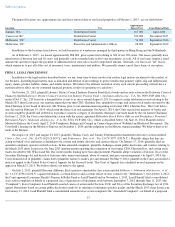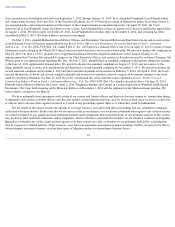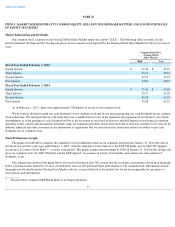Lululemon 2014 Annual Report Download - page 11
Download and view the complete annual report
Please find page 11 of the 2014 Lululemon annual report below. You can navigate through the pages in the report by either clicking on the pages listed below, or by using the keyword search tool below to find specific information within the annual report.
Table of Contents
margin to decline if we are unable to offset these factors with reductions in operating costs and could have a material adverse effect on our
financial conditions, operating results and cash flows.
If we are unable to anticipate consumer preferences and successfully develop and introduce new, innovative and updated products, we
may not be able to maintain or increase our sales and profitability.
Our success depends on our ability to identify and originate product trends as well as to anticipate and react to changing consumer
demands in a timely manner. All of our products are subject to changing consumer preferences that cannot be predicted with certainty. If we are
unable to introduce new products or novel technologies in a timely manner or our new products or technologies are not accepted by our guests,
our competitors may introduce similar products in a more timely fashion, which could hurt our goal to be viewed as a leader in technical athletic
apparel innovation. Our new products may not receive consumer acceptance as consumer preferences could shift rapidly to different types of
athletic apparel or away from these types of products altogether, and our future success depends in part on our ability to anticipate and respond to
these changes. Failure to anticipate and respond in a timely manner to changing consumer preferences could lead to, among other things, lower
sales and excess inventory levels. Even if we are successful in anticipating consumer preferences, our ability to adequately react to and address
those preferences will in part depend upon our continued ability to develop and introduce innovative, high-quality products. Our failure to
effectively introduce new products that are accepted by consumers could result in a decrease in net revenue and excess inventory levels, which
could have a material adverse effect on our financial condition.
Our results of operations could be materially harmed if we are unable to accurately forecast guest demand for our products.
To ensure adequate inventory supply, we must forecast inventory needs and place orders with our manufacturers based on our estimates of
future demand for particular products. Our ability to accurately forecast demand for our products could be affected by many factors, including an
increase or decrease in guest demand for our products or for products of our competitors, our failure to accurately forecast guest acceptance of
new products, product introductions by competitors, unanticipated changes in general market conditions, and weakening of economic conditions
or consumer confidence in future economic conditions. If we fail to accurately forecast guest demand we may experience excess inventory levels
or a shortage of products available for sale in our stores or for delivery to guests.
Inventory levels in excess of guest demand may result in inventory write-downs or write-offs and the sale of excess inventory at
discounted prices, which would cause our gross margin to suffer and could impair the strength and exclusivity of our brand. Conversely, if we
underestimate guest demand for our products, our manufacturers may not be able to deliver products to meet our requirements, and this could
result in damage to our reputation and guest relationships.
Our inability to safeguard against security breaches with respect to our information technology systems could disrupt our operations.
Our business employs systems and websites that allow for the storage and transmission of proprietary or confidential information
regarding our business, guests and employees including credit card information. Security breaches could expose us to a risk of loss or misuse of
this information and potential liability. We may not have the resources or technical sophistication to be able to anticipate or prevent rapidly
evolving types of cyber-attacks. Actual or anticipated attacks may cause us to incur increasing costs including costs to deploy additional
personnel and protection technologies, train employees and engage third party experts and consultants. Advances in computer capabilities, new
technological discoveries or other developments may result in the technology used by us to protect transaction or other data being breached or
compromised. Data and security breaches can also occur as a result of non-technical issues including intentional or inadvertent breach by
employees or persons with whom we have commercial relationships that result in the unauthorized release of personal or confidential
information. Any compromise or breach of our security could result in a violation of applicable privacy and other laws, significant litigation and
potential liability and damage to our brand and reputation or other harm to our business.
Any material disruption of our information systems could disrupt our business and reduce our sales.
We are increasingly dependent on information systems to operate our e-commerce websites, process transactions, respond to guest
inquiries, manage inventory, purchase, sell and ship goods on a timely basis and maintain cost-efficient operations. Any material disruption or
slowdown of our systems, including a disruption or slowdown caused by our failure to successfully upgrade our systems, system failures,
viruses, computer "hackers" or other causes, could cause information, including data related to guest orders, to be lost or delayed which could-
especially if the disruption or slowdown occurred during the holiday season-result in delays in the delivery of products to our stores and guests
or lost sales, which could reduce demand for our products and cause our sales to decline. If changes in technology cause our information systems
to become obsolete, or if our information systems are inadequate to handle our growth, we could lose guests.
7

